2020 Jeep Wrangler Review
What's new
- New diesel-powered V6 engine option
- New V6 mild hybrid engine option on Sahara Unlimited trim
- New Altitude variant for Sport and Sahara models
- New special-edition models added; Moab trim discontinued
- Part of the fourth Wrangler generation introduced for 2018
2020 Jeep Wrangler EcoDiesel First Drive
Torque: It's What's for Dinner
What is it?
We've been fans of the Jeep Wrangler's new JL generation ever since it debuted in the 2018 model year. There's very little wrong with this rugged off-road machine. But one thing has been missing from the start: the 3.0-liter EcoDiesel V6 option that was described in the very earliest press releases. Now, at long last, the 2020 Jeep Wrangler is finally available with the promised EcoDiesel V6, and the wait has been well worth it.
You might assume that this 3.0-liter EcoDiesel V6 is the same revamped engine recently reintroduced in the 2020 Ram 1500 lineup. But this EcoDiesel is not exactly the same because the Wrangler has a much smaller engine compartment and must retain the ability to ford streams as much as 30 inches deep. As such, Jeep had to make changes such as moving the alternator up higher and fully redesigning the air intake and accessory drive belt system. This led to a unique engine block casting. And so it went.
The result is 260 horsepower and 442 lb-ft of torque. That's slightly less power than the Wrangler's 2.0-liter turbo-four and 3.6-liter V6, but its torque output crushes them both because neither gasoline engine can muster even 300 lb-ft. We may have been sold on horsepower our entire lives, but torque is what you feel when the light turns green, when you roll onto the throttle to pass someone, or when you creep over a fallen log or any rocky off-road obstacle.
Interestingly, the EcoDiesel Rubicon comes with 3.73-to-1 gearing instead of the 4.10-to-1 ratio used in the gasoline versions. It may sound like a disadvantage at first, but axle gearing is really just a torque multiplier, and the diesel engine has a huge built-in advantage. The EcoDiesel makes 55% more torque than the torquiest gasoline offering. So even with its 3.73 axles, the diesel Rubicon can put down 41% more torque than a gas-engine Rubicon with 4.10 axles. This axle gearing issue is a nonissue.
Such a big wallop of torque means that the Wrangler EcoDiesel is only available with the eight-speed automatic transmission. The six-speed manual simply can't hack it. In fact, the diesel does not even use the same eight-speed automatic that's paired with the Wrangler's gasoline engines. Diesel power brings with it a stronger version of this gearbox that has been borrowed from the Ram 1500 pickup. All of the gear ratios in both transmissions are identical, but the calibration of its shift timing of the heftier Ram gearbox has been adjusted to better suit the needs of the Wrangler.
You can get the EcoDiesel in the Sport, Sahara and Rubicon models, but only in the Unlimited four-door body style, which makes sense in practical terms. Jeep believes the smaller and lighter two-door does not necessarily need the extra grunt. Beyond that debatable point, the reality is there simply isn't enough underbody space to package the diesel engine's more complex exhaust system.
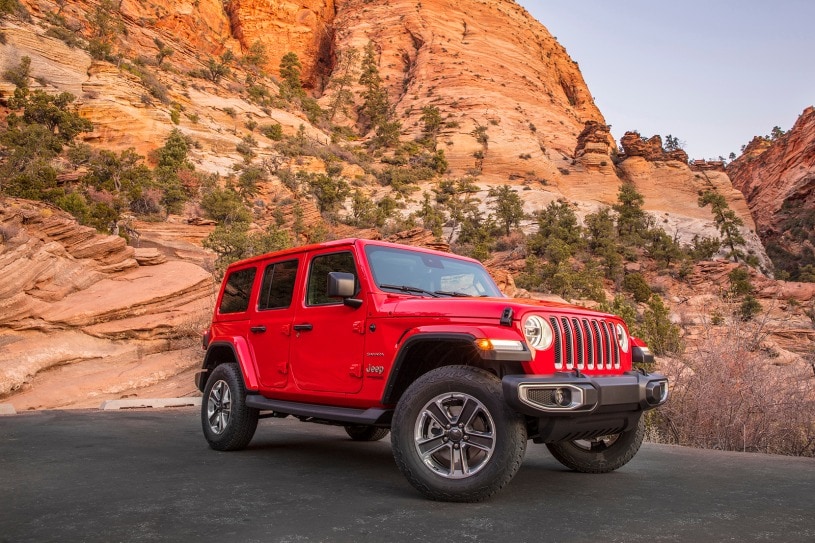
Why does it matter?
A diesel's massive torque and superior fuel economy (and therefore driving range) are significant advantages when you're exploring wild places. But abundant torque and driving range are also beneficial to pavement-bound consumers. A diesel engine can be a hard sell in the case of sedans and more family-oriented SUVs because of its noise and vibration, but Jeep people might see it as a feature, not a drawback.
What does it compete with?
The iconic Jeep Wrangler lives in a segment unto itself. But various vehicles come close. These include the Toyota 4Runner and certain midsize trucks that do well off-road such as Jeep's own Gladiator, the Toyota Tacoma (TRD Off-Road and TRD Pro), as well as the Chevrolet Colorado ZR2. The new 2020 Ford Bronco is certain to be in the hunt, but what we know so far suggests it'll be more like Ford's take on a 4Runner instead of an all-out assault on the Wrangler. Among the group, only the Chevrolet Colorado ZR2 offers a diesel engine option.
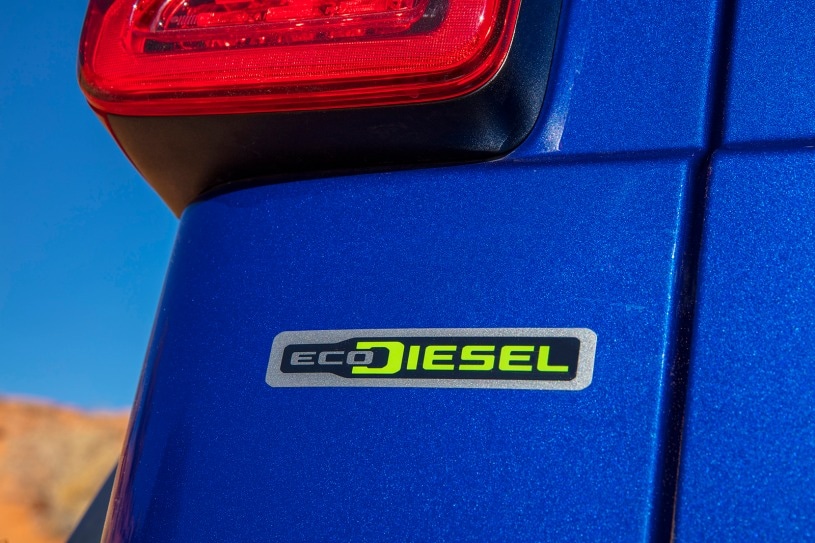
How does it drive?
Upon startup, the diesel engine settles into a familiar clattering idle, and you'll still hear it grumbling while you bop around at parking-lot speeds. It's not an obnoxious sound, and here in a Wrangler, you can even argue it adds character.
The EcoDiesel's abundant torque lives up to all the advance billing. Acceleration is smooth and strong. At cruising speed, the sound of the diesel disappears into the background — which, in a boxy Jeep, consists of a not insignificant level of wind noise. It only comes back into consciousness when things load up as you climb a grade or pull out to make a pass. In cases like this, it's not necessary to instinctively jump on the throttle to force the transmission to kick down a couple of gears. It just moves out smartly, dropping down what feels like one gear, at most.
It rides and handles much like any equivalent gasoline-powered Wrangler we've driven. We test-drove both the subdued Sahara and the rowdy Rubicon. Both are steady, and the steering feel that comes with the Wrangler's solid front axle and recirculating-ball steering is the same as ever: indistinct and vague, but somehow predictable and easy to manage.
It's all part of the plan. These vehicles aren't supposed to feel any different from their gasoline counterparts. Jeep retuned the suspension but only to compensate for the heavier mass of the diesel powertrain and its exhaust after-treatment systems.
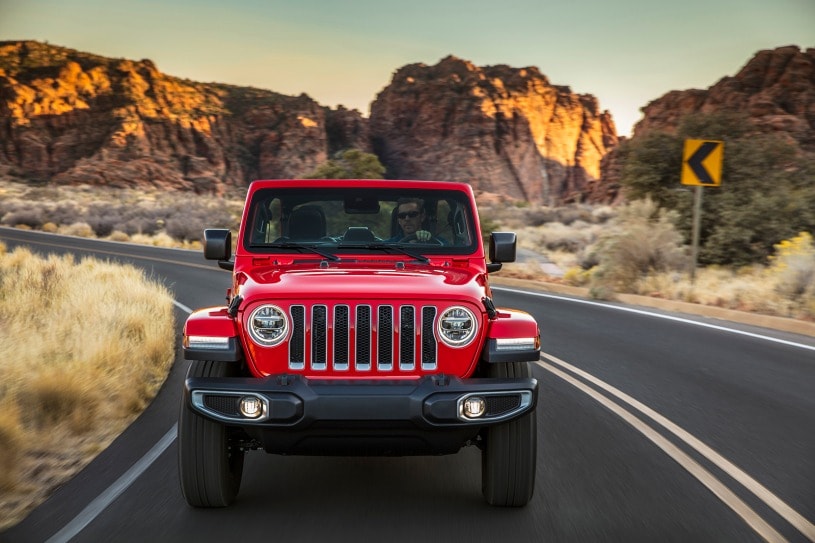
How is it off-road?
The diesel's extra torque is even more eye-opening when pavement turns to dirt, and after dirt turns to deep sand and rocks. Our test course consisted of large boulders, sandstone ledges, awkward off-camber situations and lots of sand. Delicate throttle control is critical in such tricky terrain, and the EcoDiesel proves to be even easier to manage than we expected.
Switch the Jeep's transfer case into low-range gearing and you've got plenty of torque, even at idle. Only gentle pressure is required to build enough steam to climb slopes you might need help climbing up on foot. Ledges and steps are easy to surmount without anything like a brute-force approach. In a weird way, it feels as if you can almost idle up and over almost anything, but at any speed you choose because you don't have to stab the throttle and rev the engine much to get the torque you need.
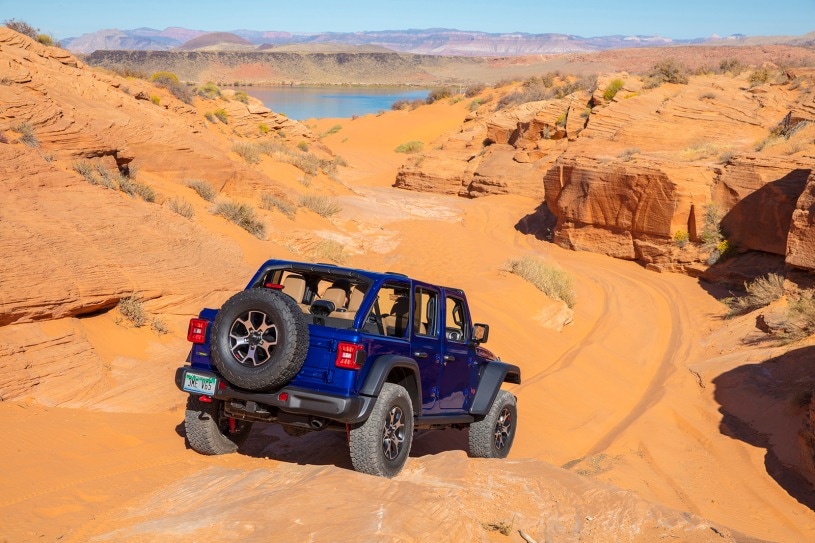
What about fuel economy and range?
EcoDiesel fuel economy and range figures have not been released, but we have enough related information to make an educated guess. Jeep engineers flatly stated that its range will exceed that of any other Wrangler. We also know that it can pull this off even though the diesel's 18.3-gallon fuel tank is 3.2 gallons smaller than what's found in gasoline-powered four-door Wranglers.
For both of those to be true, the EcoDiesel's fuel economy would have to be at least 25 mpg combined or 26 mpg on the highway, depending on how you approach the calculation. Either way, those figures are 4 mpg — some 20% — better than the corresponding figures associated with the Wrangler Unlimited's turbocharged 2.0-liter four-cylinder or 3.6-liter V6 when paired to the eight-speed automatic transmission.
The ratings even stand a fair chance of coming in higher. Jeep has not said how much better the EcoDiesel's range will be, so in our back-of-envelope calculations we could only assume the range equals that of current Wranglers. What's more, our long-term testing observations suggest that diesels are far likelier to meet or beat their EPA fuel economy estimates, and that would only widen the EcoDiesel's real-world advantage.
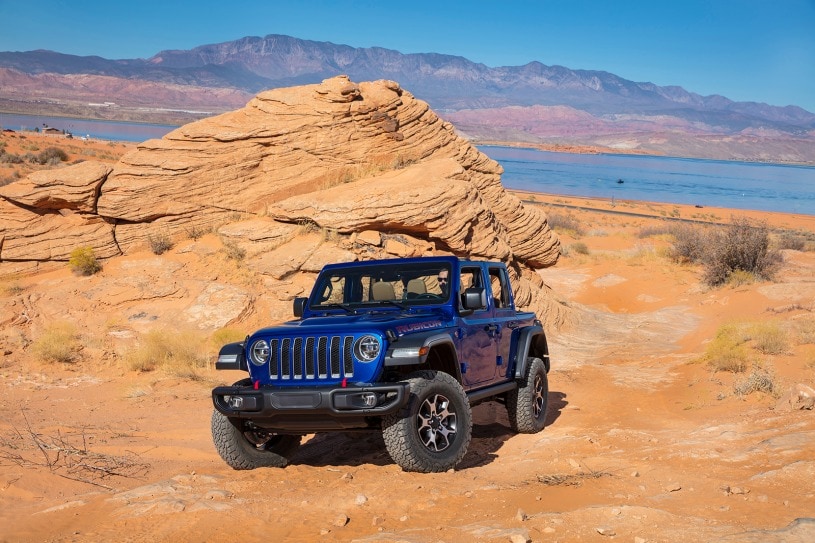
How else does the EcoDiesel differ?
Increased diesel torque does add strain to the system, and the beefier version of the transmission is not the only standard upgrade. Diesel-equipped Sport and Sahara models also come with the same wide-track heavy-duty Dana 44 front and rear axles that are already on a Wrangler Rubicon — but without the lockable front and rear differentials. And all share the diesel Rubicon's axle ratio of 3.73-to-1, too. These details make the diesel more attractive to those who would use a Sport or Sahara as the basis for a custom build.
Inside, there are no new options, and the cabin retains the same attractive design, impressive build quality and logically arranged controls. If you scroll through the EcoDiesel's information screens, you will find a new page in the vehicle status section that indicates the current level of the diesel exhaust fluid (DEF) tank, but that's about it.
That tank is located left of center between the trailer hitch and the rear axle. If there were such a thing as a Field Guide to the North American Jeep, it'd suggest you look below the bumper for the telltale lower edge of the 5.1-gallon DEF tank to identify a diesel-powered Wrangler. This tank doesn't hang down enough to hamper the all-important departure angle, but Jeep did see fit to protect it with a sturdy new skid plate.
The DEF filler port itself is not obvious because Jeep managed to wedge it into the same round fuel door opening found on any other current-model Jeep. You'll see it instantly whenever you'll fuel up, but Jeep says you won't have to add DEF between oil changes unless you only add a single 2.5-gallon jug at a time, as we tend to do. In that case, you might add a jug every 5,000 miles, give or take.
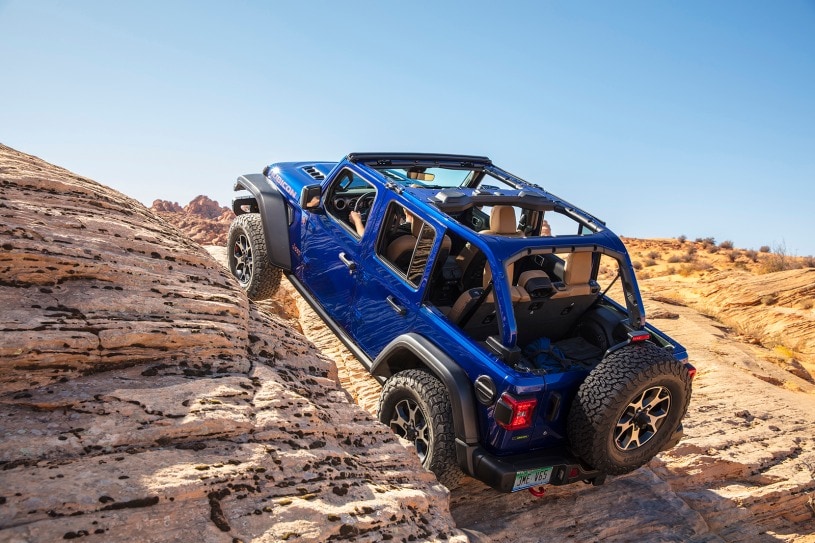
What else should I know?
There are a few other changes for the 2020 Jeep Wrangler. In 2019, the four-cylinder engine came standard with eTorque, a mild hybrid system intended to boost fuel economy slightly. It does nothing to boost peak torque, however, and the eTorque fitment makes that engine more expensive than the 3.6-liter V6 (without eTorque).
This year Jeep has straightened that out in two ways. The eTorque system has been removed from the 2.0-liter engine in the Sport and Rubicon trim lines, where the progression for automatic-transmission buyers is 2.0-liter at the bottom, 3.6-liter V6 in the middle and 3.0-liter EcoDiesel V6 at the top. Automatic buyers on the Sahara side will see the 2.0-liter with eTorque as its base offering, a new 3.6-liter V6 with eTorque in the middle and the 3.0-liter EcoDiesel once again at the top. In all cases and all trim lines, the cheapest offering remains the 3.6-liter V6 paired with a six-speed manual transmission.

Pricing and availability
A dealer can submit your order for a Jeep Wrangler EcoDiesel right now. But you might actually be able to get your hands on one sooner if you wait until they start arriving in dealerships in late December and early January.
All powertrains are options when it comes to Jeep pricing, so figuring out the cost of the diesel is somewhat formulaic. The 2.0-liter engine and its automatic cost $1,500 more than the base manual-transmission setup, and the 3.6-liter V6 with an automatic costs $1,250 more than that. From there, the step up to the diesel is another $3,250. This price ladder is slightly different with the Sahara because of eTorque.
The upshot of all this is that the cheapest diesel-powered Wrangler Sport four-door with no options will cost you $39,290, including destination charges.
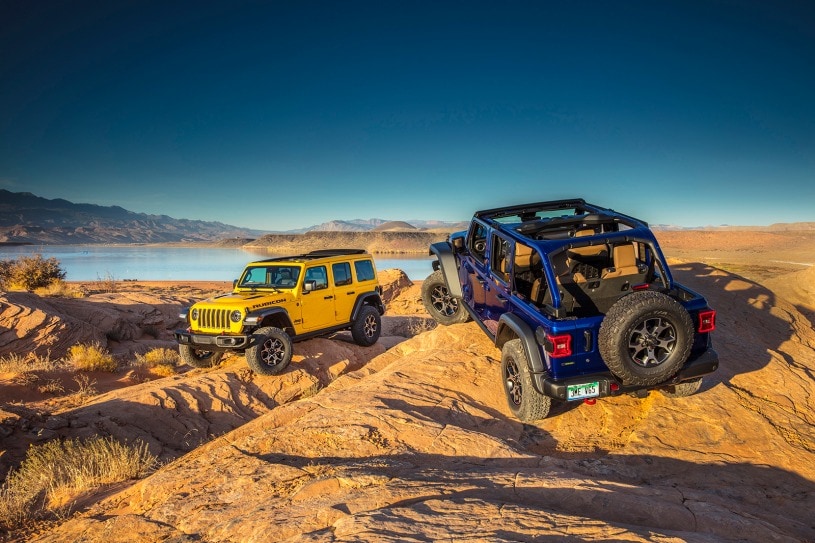
Edmunds says
We've put more than 40,000 miles on our own long-term Jeep Wrangler Unlimited four-door. We're confident that we would have enjoyed every one of those miles much more had the EcoDiesel engine been available when we bought it. Even if it never pays for itself in fuel savings, the EcoDiesel is worth considering.

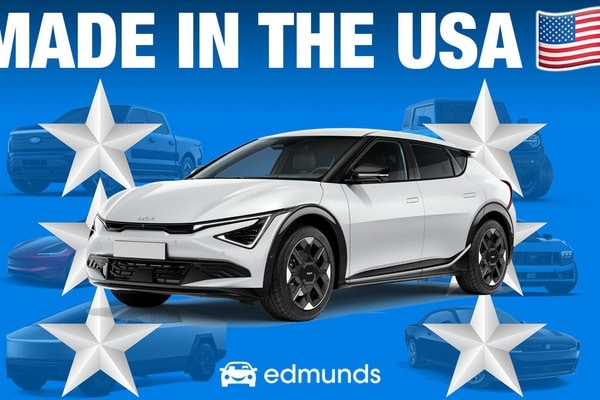


Cost to Drive
See Edmunds pricing data
Has Your Car's Value Changed?
Used car values are constantly changing. Edmunds lets you track your vehicle's value over time so you can decide when to sell or trade in.

Reliability Ratings by RepairPal
Cost
for Average Compact SUV
Frequency
for Average Compact SUV
Severity
for Average Compact SUV
Jeep Wrangler Owner Reviews
Most Helpful Owner Reviews
Trending topics
Capable but not for everyone
4 out of 5 starsI wish I could give this one star
1 out of 5 starsIt's a TRUE SUV!
4 out of 5 starsCylinder head failures
1 out of 5 stars2020 Jeep Wrangler videos
2020 Land Rover Defender vs. Wrangler vs. 4Runner — The New Defender Goes Off-Road With the Big Boys
2020 Wrangler Highlights
| Base MSRP Excludes Destination Fee | $28,295 |
|---|---|
| Engine Type | Gas |
| Combined MPG | 20 MPG |
| Cost to Drive | $166/month |
| Seating | 4 seats |
| Cargo Capacity All Seats In Place | 12.9 cu.ft. |
| Drivetrain | four wheel drive |
| Warranty | 3 years / 36,000 miles |
Safety
Our experts like the Wrangler models:
- ParkView Rear Back-Up Camera
- Displays on the center console what is behind you. Rearview cameras aren't new, but they are a welcome addition in the Wrangler.
- Blind-Spot and Cross-Path Detection
- Warns the driver of other cars in the blind spots and approaching cars from out of the driver's view while in reverse.
- ParkSense Rear Park Assist System
- Gives audio alerts when approaching objects from the rear, helping to minimize low-speed bumps in parking scenarios.
NHTSA Overall Rating
- Frontal Barrier Crash RatingOverall4 / 5Driver4 / 5Passenger4 / 5
- Side Crash RatingOverallNot Rated
- Side Barrier RatingOverallNot RatedDriverNot RatedPassengerNot Rated
- Combined Side Barrier & Pole RatingsFront SeatNot RatedBack SeatNot Rated
- RolloverRollover3 / 5Dynamic Test ResultNo TipRisk Of Rollover27.9%
People who viewed this also viewed
| 5.0 average Rating out of 1 reviews. |
| Starting at $38,995 |
| 5.0 average Rating out of 1 reviews. |
| Starting at $50,695 |
| 2.8 average Rating out of 9 reviews. |
| Starting at $36,495 |
Related Used 2020 Jeep Wrangler info
Vehicle reviews of used models
- Tesla Model Y 2021 Review
- Jeep Grand Cherokee L 2021 Review
- Mercedes Benz S Class 2020 Review
- Maserati Quattroporte 2021 Review
- GMC Terrain 2020 Review
Shop similar models
Shop used vehicles in your area
- Used Jeep Wrangler 2010
- Used Jeep Wrangler 2011
- Used Jeep Wrangler 2012
- Used Jeep Wrangler 2013
- Used Jeep Wrangler 2014
- Used Jeep Wrangler 2015
- Used Jeep Wrangler 2016 For Sale
- Used Jeep Wrangler 2017
- Used Jeep Wrangler 2018
- Used Jeep Wrangler 2019
Popular new car reviews and ratings
- 2025 Toyota Pickup
- 2025 Ford F-150
- 2024 INFINITI EX
- 2026 Hyundai Santa Fe News
- 2024 Chevrolet Camaro
- New Mercedes-Benz GLE
- 2026 Toyota BZ News
- New Toyota BZ
- 2024 Hyundai Santa Cruz
- 2024 Buick Enclave
Research other models of Jeep
- 2025 Wrangler
- New Jeep Grand Cherokee
- 2025 Jeep Compass
- New Jeep Grand Cherokee L
- 2024 Wrangler
- New Jeep Wagoneer L
- 2025 Jeep Gladiator
- Jeep Grand Cherokee 2024
- 2026 Jeep Cherokee
- 2025 Grand Wagoneer L
Research similar vehicles
Other models
- Used Volvo V60-Cross-Country in Forney, TX 2025
- Used Mercedes-Benz 600-Class in Wesley Chapel, FL 1993
- Used Alfa-Romeo Tonale in Glens Falls, NY 2025
- Used Honda Prologue in Lufkin, TX 2025
- Used Subaru Legacy in Kingsport, TN 2025
- Used Hyundai Tucson-Plug-In-Hybrid in West Chester, PA 2025
- Used BMW 3-Series-Edrive in Jacksonville, IL 2016
- Used Saturn Vue-Hybrid in Everett, WA 2009
- Used Pontiac G6 in Lake Stevens, WA 2010
- Used Tesla Roadster in Thomasville, GA 2011
